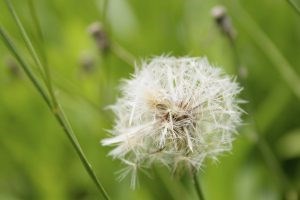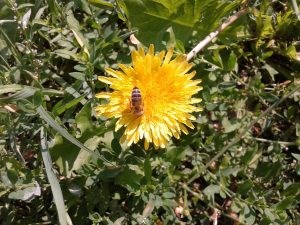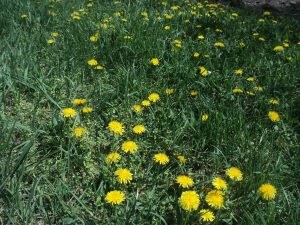This content was originally published by the Longmont Observer and is licensed under a Creative Commons license.
Spring is just around the corner and a common harbinger of spring is making its appearance. Some love them and for others, they are the bane of a good-looking lawn. Love them or hate them, dandelions are on their way. I thought this might be a good time to write a bit about their biology and some of their uses, as well as perhaps a way to control them if you don’t want to share your lawn.
Dandelions get their name from a French term “dent de lion,” which means “tooth of the lion.” They are a member of the aster family (Asteraceae or Compositaceae). This means that what you think of as a single flower is actually hundreds of tiny flowers called ray flowers. Each dandelion contains 100-300 ray flowers.
Dandelions are actually native to Europe and Asia, but it has been spread worldwide. The earliest recorded occurrence of the dandelion dates back to Roman times. The use of the dandelion was recorded by the Anglo Saxons of Britain and the Normans of France. Arabian physicians mention its use as a medicinal herb in the eleventh and twelfth centuries. It is thought that the Puritans brought dandelions with them when they came to America.

Dandelions have yellow flowers and a rosette of serrated leaves. The leaves are between 3-12 inches long and 0.5-2.5 inches wide. They are hairless and shiny. When picked, the stems exude a milky substance which is actually latex, a key component of rubber. German scientists have actually engineered a dandelion plant that exudes five times more latex than average. The flower stalk itself is 6-24 inches in length.
Dandelions have tap roots that can extend up to 15 feet below ground, which helps explain why they are so hard to control. Dandelions are able to regenerate from the tap root even when the root has been cut. The seed heads are downy. According to folklore, you can tell what time it is by seeing how many blows it takes to completely clear a dandelion puff of its seeds and down. Each dandelion flower can produce up to 2,000 seeds! Although dandelions can grow just about anywhere, they tend to like sunny, moist spots. They are found more frequently in disturbed areas.
Most people think of dandelions as a weed, but it has been used both for medicinal and culinary purposes. It has been scientifically proven to be a diuretic and a laxative. Dandelions have also been used to purify the blood and to treat rheumatic problems. In China, India, and Russia, the dandelion was used to treat liver problems and still is in some places today. It was also used to treat breast and digestive problems. Europeans used the dandelion medicinally as well to treat everything from fevers to skin problems. The dandelion is thought to aid in digestion because its bitterness stimulates salivary and gastric juices.
There have been studies showing that dandelions can produce antibodies to cancer and help control blood glucose levels. The leaves have diuretic properties and can produce significant weight loss as a result. The root is thought to help the liver. One half cup of dandelions contains more calcium than a cup of milk and more iron than spinach. Dandelions also contain large amounts of vitamins C, A, and K.

All parts of the plant are edible. The taste of dandelions is similar to chicory or endive and is bitter. Steaming or otherwise cooking the leaves helps remove some of the bitterness. Dandelions are used in salads or eaten roasted or fried. They have also been used to make wine, tea, or a coffee-like drink. In fact, the dried root was used to make a coffee substitute during WWII when coffee rationing was in effect. The flowers are sweet and crunchy and can be used raw in salads or cooked. Dandelion flowers are also used to make dandelion wine. You can find more recipes for dandelions here.
If you’ve decided to give dandelions a try in your diet, there are some things to keep in mind about harvesting them. Don’t harvest dandelions next to a road or an industrial lot as they pick up pollution. Be sure that no pesticides have been used where you are harvesting the dandelions. The best time to harvest dandelions is in the spring as fall dandelions tend to be more bitter. Also, the older a dandelion is, the more bitter it will be.
Younger leaves will be on the inside of the growth. The best greens come from plants that have not yet produced a flower. The sweetest part of the dandelion is the crown. The crown is produced just before a plant flowers and is a densely packed circle of small leaves. When harvesting flowers, separate the flower from the green base as the base is very bitter.

However, if you don’t want dandelions in your yard, it is best to try to stop them while they are still seedlings. Once established, dandelions are very hard to control. You can try pulling them, but with the long taproot, they can be hard to get out. Water the ground first so that it is moist, which will help. You can also buy specially designed tools to help get the taproot out. You can use vinegar to kill dandelions naturally, but be careful not to get it on anything you don’t want to kill. Preventative lawn maintenance is the best method of controlling dandelions. Try leaving grass clippings on your lawn to act as a mulch and help prevent seeds from germinating. Leave the grass 2-3 inches tall to prevent light from getting to the seeds. Overseed any bare spots so that dandelions don’t have a chance to establish themselves.
Love them or hate them, dandelions are a part of spring and summer. Consider embarking on a new culinary adventure and try them in a salad or even making dandelion wine. You may find you have a new favorite food!


